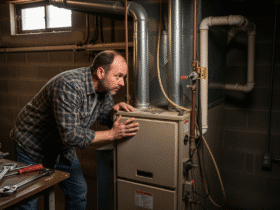Table of Contents
- Water-Efficient Fixtures
- Energy-Efficient Water Heating
- Greywater Recycling Systems
- Sustainable Plumbing Materials
- Smart Plumbing Technologies
- Rainwater Harvesting Systems
- Permeable Paving Systems
- Water-Saving Appliances
Introduction
Sustainability in home design extends well beyond the addition of energy-efficient lighting fixtures and rooftop solar panels—it encompasses every system that manages water flow, heating, and waste within a household. While most homeowners understand the importance of energy conservation, it is equally vital to pay attention to how water, one of our most precious resources, is managed daily. Advanced, eco-conscious plumbing solutions are at the forefront of sustainable living, offering homeowners not only tangible benefits in resource conservation but also notable savings on monthly utility bills and increased long-term property value. For residents of Denver experiencing plumbing emergencies or seeking advice on sustainable upgrades, Denver emergency plumbing services are available 24/7, providing expert guidance and prompt services for immediate repairs and environmentally responsible plumbing installations. By partnering with professionals who understand sustainable plumbing, households can take confident steps toward creating a more efficient and accountable home environment.
Embracing these modern plumbing methods can significantly reduce both water and energy consumption, allowing homeowners to play an active role in broader conservation efforts while enhancing the performance, efficiency, and resilience of their homes’ essential systems. Modern plumbing isn’t just about preventing leaks or ensuring water flows—it’s about building a foundation for a sustainable future.
Water-Efficient Fixtures
Installing water-efficient fixtures such as low-flow toilets, faucets, and showerheads is a straightforward and cost-effective way to begin transforming a standard home into a model of sustainability. Modern plumbing fixtures are engineered to minimize water usage while maintaining, or even exceeding, the performance of traditional models. The EPA’s WaterSense program sets the industry standard for fixture performance and water efficiency, certifying only those products that meet rigorous testing for quality and performance. For example, a WaterSense-labeled toilet uses at least 20% less water per flush compared to standard models, helping an average family save up to 16,000 gallons of water each year. These simple upgrades, often requiring only a minor upfront investment, provide a quick return by significantly lowering monthly water bills and reducing the household’s overall environmental footprint. In addition to toilets, WaterSense products include showerheads that offer strong pressure while minimizing flow and faucets designed to deliver water efficiently. For homeowners looking to upgrade, a comprehensive list of approved and certified fixtures is available on the EPA’s WaterSense Products page, offering an easy starting point for eco-friendly renovations. Beyond saving water, these fixtures are a smart investment for increasing a home’s value and appeal to environmentally conscious buyers.
Energy-Efficient Water Heating
Water heating is often one of the highest energy-consuming activities in residential properties. Traditional tank-style water heaters continually heat and store large volumes of water, resulting in energy waste even when hot water is not being used. To counteract this inefficiency, more families are replacing old heaters with modern alternatives. Tankless water heaters, for example, only heat water when it’s needed, dramatically reducing energy consumption and ensuring households never run out of hot water during periods of heavy use. Solar water heating further minimizes a home’s carbon footprint by capturing the sun’s energy, reducing dependence on fossil fuels, and lowering monthly utility costs. In addition, heat pump water heaters utilize advanced technology to extract heat from the ambient air and transfer it into the water, operating with up to 60% greater efficiency than standard electric models. This variety of options allows homeowners to choose a solution that best fits their usage patterns and climate, with each offering significant long-term savings and a positive impact on the environment. For those interested in more information, the U.S. Department of Energy provides a comprehensive resource on the latest efficient water heating technology; see their Water Heating page for expert advice and guidance.
Greywater Recycling Systems
As concerns about water scarcity rise, especially in drought-prone regions, greywater recycling systems have gained considerable attention in sustainable home design. These innovative systems capture gently used water from sources such as bathroom sinks, showers, and laundry, and redirect it for beneficial uses that do not require potable-quality water, such as landscape irrigation and toilet flushing. By diverting greywater from the main sewage line, these systems can help reduce a home’s fresh water usage by as much as half, substantially lightening the load on both municipal water supplies and local wastewater treatment facilities. Implementing a greywater system requires an understanding of local regulations concerning water reuse, potential filtration needs, and routine maintenance to prevent odors or blockages. However, for homeowners willing to work with experienced professionals, the long-term environmental and financial savings are considerable. Greywater recycling not only reduces demand for fresh water but also offers resilience in times of drought or watering restrictions.
Sustainable Plumbing Materials
The selection of materials used in plumbing not only affects the immediate function of a home’s water system but can also have long-lasting impacts on the property’s sustainability. Contemporary materials like PEX (cross-linked polyethylene) are increasingly popular due to their outstanding durability, resistance to corrosive chemicals, and flexible installation requirements, which result in fewer joints and, consequently, fewer potential leak points. The manufacturing of PEX generally consumes less energy and generates less waste compared to older materials such as PVC or copper. When metal piping is required, choosing recycled-content copper or other metals further reduces the environmental impact associated with the extraction and processing of raw materials. Additionally, locally sourced materials can further diminish the carbon footprint associated with transportation. Homeowners who prioritize these options often find that sustainable plumbing materials last longer, require less maintenance, and can increase the overall value and reliability of their plumbing systems, while helping to build a more responsible and future-proof home.
Smart Plumbing Technologies
The smart home revolution is making water management more convenient and effective. Smart plumbing technology features leak detectors that monitor water flow in real-time, instantly alerting homeowners via their smartphones if a leak or burst pipe is detected. Many systems can even automatically shut off the water supply at the source, preventing potential flooding and costly damage. These tools offer both immediate protection and peace of mind, particularly for homeowners who travel frequently or own second homes. Additionally, smart irrigation controllers eliminate the guesswork of watering lawns and gardens by synchronizing with local weather forecasts or utilizing soil moisture sensors to ensure landscapes receive only the necessary water, thereby reducing both waste and overwatering. For more water-saving smart home upgrades, the EPA maintains a helpful list of water-efficient products on the WaterSense Products site, making it easier for homeowners to select technology that improves efficiency and saves resources over time.
Rainwater Harvesting Systems
Rainwater harvesting is an ancient practice experiencing a modern resurgence, enabling households to use collected rainwater for non-potable purposes such as irrigation, exterior washing, or toilet flushing. A rainwater harvesting setup typically comprises gutters that channel rain from the roof into storage barrels or tanks, which can be fitted with simple filtration systems to prevent debris buildup. During dry spells, the stored rainwater acts as a crucial reserve, relieving pressure on municipal systems and providing a buffer against watering restrictions or supply interruptions. Many local governments now offer financial incentives or rebates to homeowners who install rainwater harvesting systems—a valuable offset for installation costs that can speed up the return on investment and help more families adopt this sustainable solution. To explore rainwater harvesting incentives and system options in Colorado and beyond, the Colorado Stormwater Center is an excellent resource.
Permeable Paving Systems
Urban development often leads to increased surface runoff and flooding because traditional materials, such as concrete or asphalt, prevent water from infiltrating into the ground. Permeable paving solutions, such as permeable concrete, open-joint pavers, or grid systems filled with gravel or grass, allow rainwater to naturally infiltrate the soil. By using these materials in driveways, walkways, or patios, homeowners not only reduce pressure on municipal stormwater systems but also contribute to groundwater recharge and the reduction of harmful runoff contaminants. These systems help manage stormwater onsite, limiting soil erosion and minimizing water pollution while contributing to a healthier, greener neighborhood. In areas affected by frequent heavy rains or flash floods, permeable paving can help prevent costly damage while supporting the broader ecosystem.
Water-Saving Appliances
Water and energy-saving appliances now offer substantial improvements in both resource conservation and household convenience. Modern dishwashers and washing machines with the ENERGY STAR label are certified to use advanced technology, such as sensors that optimize water usage based on the size and soil level of each load. This not only results in cleaner dishes and laundry but also limits unnecessary consumption, saving both water and energy with every cycle. In many cases, these high-efficiency appliances use half—or even less—of the water volume required by their predecessors, representing a significant cumulative savings over the years. For consumers prioritizing sustainability, reliable guides and reviews from outlets such as Consumer Reports can help select dishwashers and washing machines that strike the best balance between efficiency, performance, and value.
By embracing modern plumbing advancements and making thoughtful upgrades, homeowners can ensure their homes operate at peak efficiency—both economically and sustainably. Every improvement amplifies a household’s impact, conserving critical resources, reducing utility costs, and future-proofing the property for new generations. Small changes made today set the foundation for a sustainable lifestyle that benefits both residents and the planet for generations to come.









